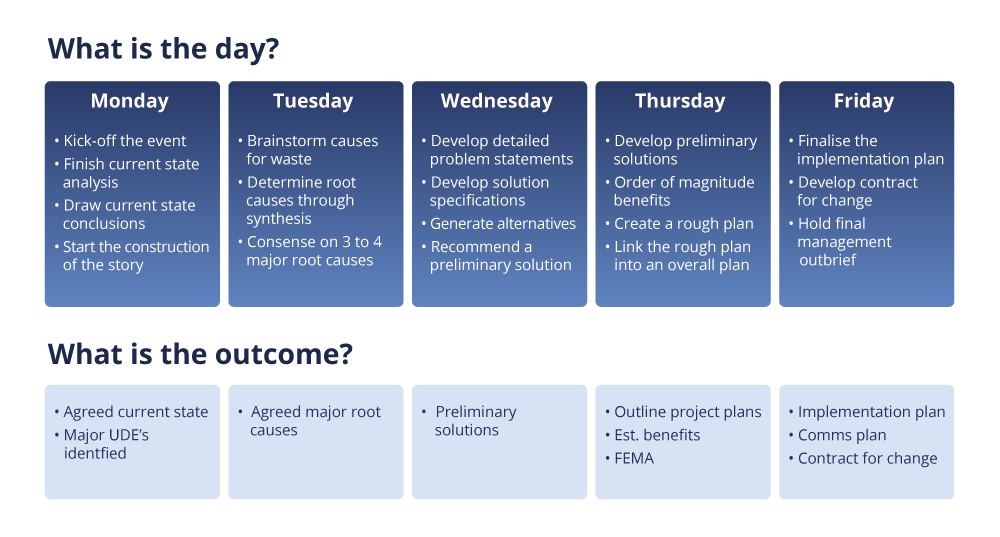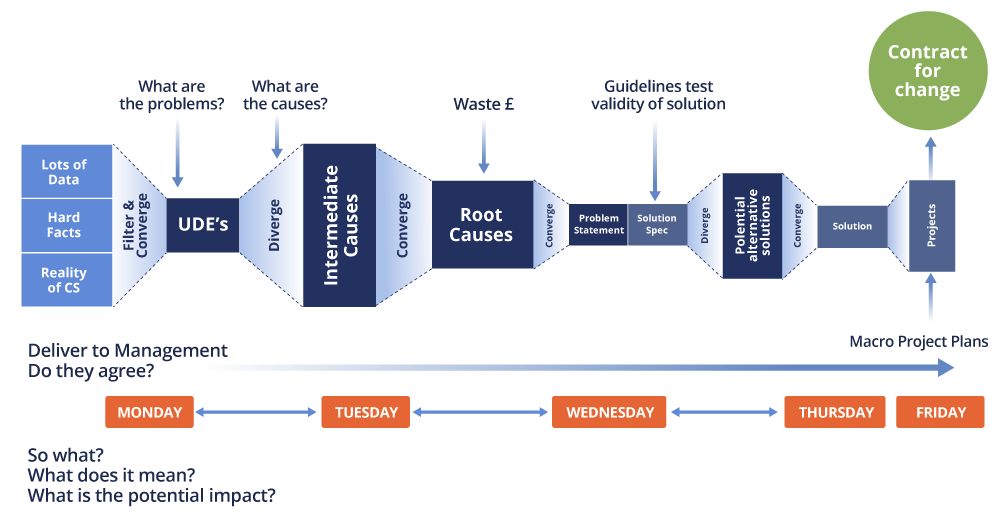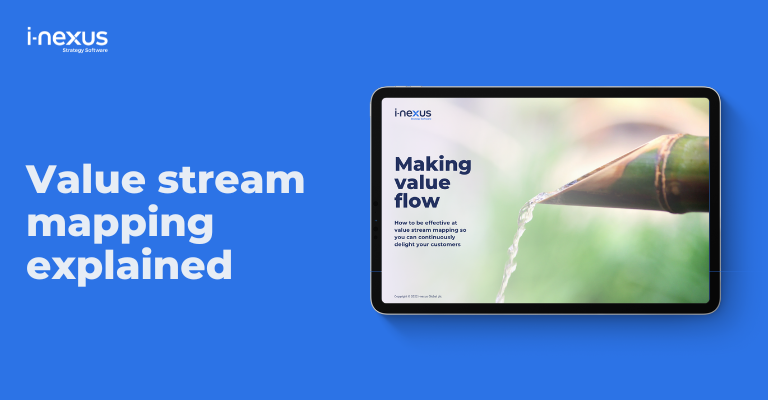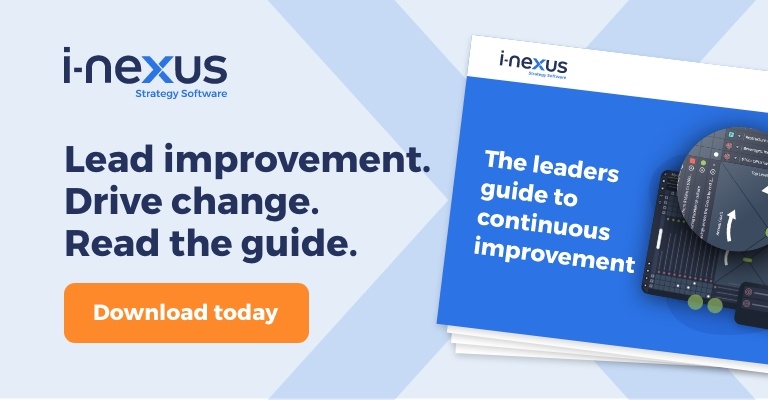It's Monday, your participants are here for your workshop - here are 4 tips to successfully facilitating your Kaizen event
Written by: Nigel Richardson
It’s Monday and you and your attendees are together ready for the Kaizen event.
There is some excitement and apprehension in the air.
This blog will take you through 4 tips to successfully facilitate your week, focusing on two levels:
- Agenda Flow
- Facilitation Challenge
Agenda flow
This is the easy bit, the plan, what “should happen” and as you can see below each day covers a key improvement phase building on the level of definition and measurement that has been completed in the prep.
When prepping the detail, I would normally produce a summary slide much like this daily summary, but with a morning and afternoon section. I also highlight a 30 min sponsor out-brief section at the end of every day.

In this Kaizen event agenda summary slide example you can see that each day provides an opportunity to utilize some of the improvement tools that we have covered in previous sections:
- Mon: Current state Value Stream map
- Tues: Root cause analysis such as Fishbone and 5 Whys
- Weds: Problem statements and prioritization approach
- Thurs: Future state Value Stream map or “to be” process mapping along with risk assessment tools such as FMEA
- Fri: Project Charters and plans
Facilitation considerations
From a facilitation perspective, this whole week can be viewed through a “diverge and converge” perspective.
We have talked about the potential risk of being overwhelmed with complexity and differences of opinion and perspective at a grand scale.
This ability to lead the group through phases of diverging and phases of converging is critical.

The goal of the facilitator is initially to diverge, gain a volume of different thoughts and perspectives, limit deep diving, group think or polarizing of opinion.
Once that broad cross section of content is captured the facilitator’s mind is drawn to converging this thoughts to ensure that the top priority items receive the focus they deserve.
This happens at many points in a Value Stream event and looks something like the below for the week overall:

4 tips for success
Some things to consider from my experience facilitating these events.
1. It is a lot for one person to run
If you are running your first event then seriously consider having another facilitator with you who has done these events before. If you do not have this luxury, then always be looking for ways to lighten the load for yourself:
- Look for participants to take on the roles of scribe, timekeeper etc. This will allow you to focus more on who people are interacting with the process by table or as individuals.
- If you have sections where some training is involved consider asking a colleague to provide this for you or explore the use of a video. Anything to break up you have to talk (a week of that and you can lose your voice...).
- As you are having your chats with participants spot the “brighter sparks” with perhaps more previous experience and enthusiasm for this type of work. Distribute those across your different groups.
2. Resistance on Monday is bad, but rebellion on Weds afternoon is good
You have been using the phrase “just go with it” quite a lot during Monday and Tuesday as people get to grips with a mindset and tool use that was previously alien to them.
However, there will normally come a point where the group genuinely wants to approach a section in a different way than the way suggested.
For me, for some reason, it was always a Wednesday afternoon.
This is a good thing, and for me, it represents a shift in accountability from a group of people following your direction to actually a group that is bought into the process and wanting to take more ownership of the outcome.
Give them this opportunity and you will see an interesting shift to a group managing their own facilitation during the individual agenda items.
This frees you up to keep an eye on the macro agenda, come in when you are asked for support (they will now call you over).
Also, this allows you to handle the “Crowd Control” role we mentioned earlier.
As the group is working you are able to walk stakeholders through the walls of information.
3. Don't be afraid of high numbers
I remember running a workshop with 30 participants on my own.
On paper, it was going to be so much harder, but in reality, I think it can be easier with a few key pointers:
Firstly, create table teams of no more than 6-7 people and ensure each one of those tables:- Does not duplicate functional reps. People that sit next to each other at work will naturally sit next to each other in workshops, have a table plan.
- Ensure you have a mixture of “early adopters” as we mentioned previously – they can keep things going.
Allow more time:
- Having multiple groups working simultaneously on the same topic acts as a form of validation.
- A really good example of this is when you are at the root cause problem solving have some tables use 5 whys and others use a fishbone.
- You will, however, need to ensure you plan 10 to 15 minutes at the end of each working section to allow each group to debrief each other and check for common threads.
4. Take stakeholders on the journey with you
- Have a daily sponsor outbrief that allows you to explain progress for the day and the key findings for each phase. You may generate some questions during that day that you need to park for the sponsor outbrief session.
- Show them the room – run the outbriefs in the room. Do not prepare slides, walk them through the wall and let them understand what they are seeing.
After the workshop
Having meticulously planned and expertly executed your Kaizen event, the next step is post-workshop.
Here, never has it been more important for you to focus, communicate and follow through on a project plan to put into action the improvement opportunities identified over the course of the week.
Continue learning about continuous improvement
Click here to learn more about continuous improvement, or take a look at these content recommendations:
- Continuous improvement in 2020 and beyond: Watch how continuous improvement will evolve into the 2020s and how you can be successful.
- DMAIC v Six Sigma v Lean: Our guide to the steps and tools you'll need when driving process improvement through one of these three methodologies.
- The Leader's Guide to Continuous Improvement: Download this eBook to get a comprehensive overview of how DMAIC, Six Sigma, Lean, PDCA can support your business in finding a competitive advantage.
About the author
Nigel Richardson is a continuous improvement expert. His background spans 20 years in business transformation and continuous improvement across retail, pharma, aviation and IT supply chain. He is passionate about supporting organizations to achieve their strategic, transformational and improvement goals, and outperform their peers year after year.
If you’d like to talk more about your strategic challenges, reach out to him on nigel.richardson@i-nexus.com or connect with Nigel on LinkedIn for the latest Strategy Execution insights.




